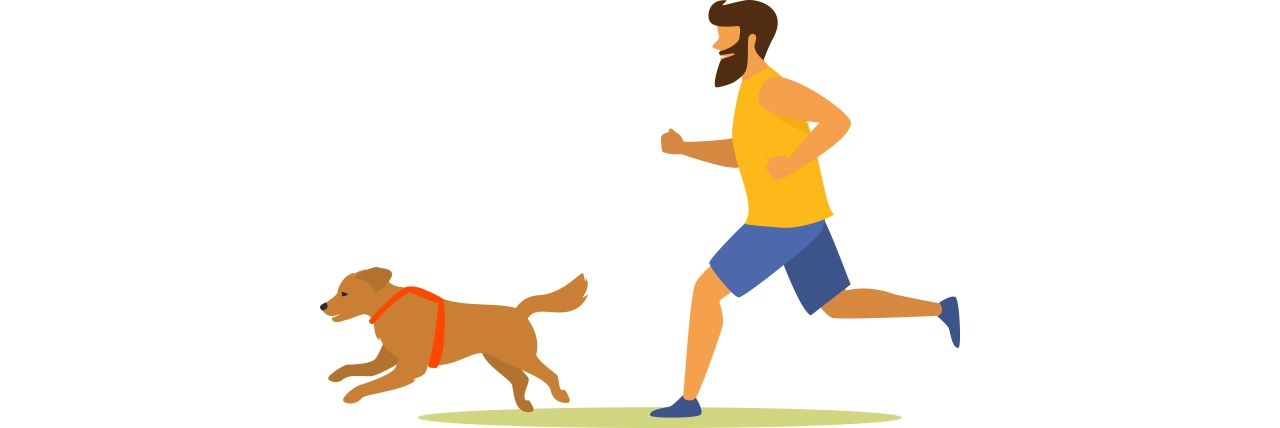How to Care for Dogs with Arthritis
Arthritis is a complex condition that causes inflammation and degeneration of one or more joints in the body. Dogs with arthritis may experience pain and swelling in the affected joints, which can invariably interfere with their daily activities and routine life.
Watching your furry friend get older is not fun, and to see them in pain is even more painful. Arthritis is caused when the cartilage between two joints becomes less smooth and gets damaged, causing the bony surfaces to rub against each other. This makes your dog’s joints swell, stiffen, and become painful. The condition can make your dog uncomfortable getting up or moving around.
Symptoms of Arthritis in Dogs
Common symptoms of arthritis in dogs include the following:
- Pain and difficulty while standing, walking, sitting up or down
- Limping on the affected leg
- Walking stiffly
- Resisting climbing the stairs
- Resisting being touched on certain parts of the body
- Loss of stamina
- Walks slowly or stood walking abruptly
- Avoids jumping up or down
- Licking or chewing on painful areas
- Behavioral changes – does not like being cuddled or touched too much
Causes of Arthritis in Dogs
There is no actual single cause for arthritis in dogs. It usually involves the following factors:
- The build of the dog
- Body condition or weight of the dog
- Abnormal joint development, like hip dysplasia, elbow dysplasia, or luxating patellas
- Nutritional history
- Injury history, like past fracture, muscle injury, ligament injury, joint infection
- Activity histor
Most dogs struggling with arthritis will have several of these factors as the cause.
Stages of Arthritis in Dogs
Arthritis in dogs develops over time due to the above factors. The condition can become progressively worse based on the stage of the disease:
Pre-Osteoarthritis – Stage 0–1
Stages 0 and 1 are prodromal stages wherein the arthritis has not yet set in. The dog is clinically normal without any symptoms. Stage 0 indicates clinical normalcy and absence of risk factors. Stage 1 indicates absence of clinical signs and symptoms with presence of one or more risk factors, like the dog’s body structure, history of joint injury, history of intense activity, or any signs of dysplasia.
Mild Osteoarthritis – Stage 2
During stage 2 arthritis, a dog’s mobility gets affected during some activities, like playing fetch or running. The subtle stiffness in gait, asymmetry while walking, and changes in body weight distribution are visible during the second stage.
Moderate Osteoarthritis – Stage 3
A dog with stage 3 arthritis will show obvious limb abnormality, stiffness in walking, and limping. You may also notice a reduction in the use of the affected limb.
Severe Osteoarthritis – Stage 4
Dogs with stage 4 arthritis often become restless while standing and may refuse to walk or stand. Other signs may include abnormal limb loading.
Signs of arthritis are usually subtle till the condition doesn’t reach the moderate and severe stages. This makes it difficult for most dog owners to get the condition diagnosed.
Long-term Arthritis in Dogs
Arthritis is a degenerative disease that can worsen with time. All the treatments available are aimed at managing the pain and discomfort along with slowing down the progression of the condition. The ultimate goal is to keep your dog comfortable and ensure they lead a good life.
Does arthritis shorten a dog’s life?
Arthritis in dogs is a chronic condition that requires life-long management. While it doesn’t shorten a dog’s life, it does worsen over time. Hence, adequate management of the condition and timely intervention are required for a better quality of life for the dog.
Should you euthanize a dog with arthritis?
Lack of mobility, where the dog can’t move or walk or even get up anymore, can cause difficulty leading a normal life. In such cases, where arthritis has progressed to the last or end stage, euthanasia may be resorted to. At this stage of arthritis, your dog may resist, cry, or even scream while being tested for range of motion in the joints. To prevent this, you may want to intervene earlier and slow down the progression of the condition.
Should you euthanize a dog with arthritis?
Lack of mobility, where the dog can’t move or walk or even get up anymore, can cause difficulty leading a normal life. In such cases, where arthritis has progressed to the last or end stage, euthanasia may be resorted to. At this stage of arthritis, your dog may resist, cry, or even scream while being tested for range of motion in the joints. To prevent this, you may want to intervene earlier and slow down the progression of the condition.
1. Regular Exercise
If your dog has arthritis, the physical therapist will suggest multiple exercises to soothe the pain and discomfort. However, the key is to keep doing the exercises, little and often. Controlled and regular exercise can help improve your dog’s daily capacity. Manual stretching exercises and a back and sacrum massage are usually recommended for dogs with arthritis.

2. Hydrotherapy
Hydrotherapy or water therapy works by placing your dog underwater on a treadmill. The treadmill sits within a four-sided glass chamber, and the dog is made to walk on the treadmill. Dogs are weightless underwater like humans, and the buoyancy helps them walk without having to worry about carrying their full weight.

3. Swimming
Since dogs are weightless underwater, getting them to swim can be beneficial for their arthritis. It is a low-impact activity for your dog to gain muscular strength and improve their range of motion.

4. Walking
Take your dog on multiple short walks every day rather than one long walk. Walking is a low-impact aerobic activity that does not put too much stress on the joints and helps build muscle strength and improve range of motion.

Making Lifestyle Changes to Improve Your Dog’s Arthritis Symptoms
Make your dog feel comfortable by ensuring the following lifestyle changes:
- Keep Your Dog Cool
Your dog should be comfortable with the surrounding temperature. Ensure that they don’t feel too hot or too cold as that can cause an increase in pain and stiffness.
- Trim Your Dog’s Nails
Trimming their nails helps reduce the pressure on their paws while they walk or stand.
- Raise Their Food and Water Bowl
This helps prevent your dog from lowering their head and straining their joints for eating and drinking.
- Prevent Slipping
Most homes have a laminate or polished flooring, which can make your dog prone to slipping. Provide a non-slip rug or shoes for your dog to walk more easily without slipping.
- Use a Ramp
Help your dog get access to every area using a ramp. This can help them climb the difficult to reach areas easily like getting into a car, or climbing up the sofa.
- Use a Harness
A supportive harness helps ensure your dog walks more steadily. The harness provides support and stability to their back legs and knees.
- Provide a Comfortable Bed
A comfortable bed helps reduce the pressure on your dog’s joints while they sleep and ensures that they rest more comfortably.
Is Heat or Cold Better for Dogs with Arthritis?
Heat helps reduce the pain and stiffness in the joints of dogs with arthritis. It also improves the blood flow to the affected joints.
How to Choose the Best Bedding and Sleeping Arrangements for Dogs with Arthritis?
Comfortable beds for dogs with arthritis are those which are low to the ground and have orthopedic support. They need to be soft to ease your dog’s pain while they lie down. Ensure that you have placed a soft and comfortable bed with non-slip mats at every favorite spot of your dog. This will help prevent injury and reduce pain when they try to stand up.
Importance of Proper Nutrition and Diet for Dogs with Arthritis
Your dog’s diet is very important when it comes to managing arthritis. Weight management in dogs with arthritis is essential, as the excessive weight can cause an added strain on your dog’s joints. Ensure you feed your dog the right food and meet their nutritional needs. A healthy diet for dogs with arthritis includes foods that contain anti-inflammatory agents, antioxidants, and omega fatty acids.
Alternative Therapies for Managing Arthritis in Dogs
Alternative therapies for dogs with arthritis include the following:
- CBD Oil
CBD oil can be used to treat arthritis in dogs. It can help in relieving the pain and discomfort. Studies are not entirely conclusive on the efficacy of this therapy, and hence, more research is required.
- Acupuncture
Acupuncture can help dogs who have chronic pain due to arthritis. The course of treatment is usually 4–6 sessions for it to be effective.
- Massage
Massaging the dog’s back and sacrum helps relieve the pain and discomfort. Start at the base of the tail, between the hip bones. Use light pressure and gently massage in a circular motion over the hard, flat surface. Proceed gently and slowly along the length of your dog’s spine. This helps improve the flow of the spinal fluid and increases the mobility of the spine and hips.
Preventing Arthritis in Dogs: What You Can Do to Promote Joint Health
Medications and Supplements for Managing Arthritis Pain in Dogs
Dogs are usually given pain medications along with nonsteroidal anti-inflammatory drugs (NSAIDs) to reduce the internal inflammation. Steroids are also given in severe cases instead of the NSAIDs.
Other supplements include glucosamine for dogs since they contain sulfates, which are the building blocks of healthy cartilage and stimulate the body to make more cartilage. Glucosamine for dogs also helps reduce their pain and discomfort.






